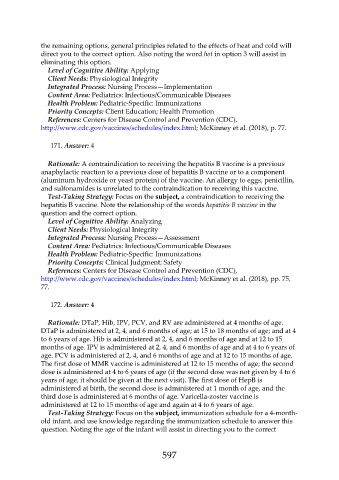Page 597 - Saunders Comprehensive Review For NCLEX-RN
P. 597
the remaining options, general principles related to the effects of heat and cold will
direct you to the correct option. Also noting the word hot in option 3 will assist in
eliminating this option.
Level of Cognitive Ability: Applying
Client Needs: Physiological Integrity
Integrated Process: Nursing Process—Implementation
Content Area: Pediatrics: Infectious/Communicable Diseases
Health Problem: Pediatric-Specific: Immunizations
Priority Concepts: Client Education; Health Promotion
References: Centers for Disease Control and Prevention (CDC),
http://www.cdc.gov/vaccines/schedules/index.html; McKinney et al. (2018), p. 77.
171. Answer: 4
Rationale: A contraindication to receiving the hepatitis B vaccine is a previous
anaphylactic reaction to a previous dose of hepatitis B vaccine or to a component
(aluminum hydroxide or yeast protein) of the vaccine. An allergy to eggs, penicillin,
and sulfonamides is unrelated to the contraindication to receiving this vaccine.
Test-Taking Strategy: Focus on the subject, a contraindication to receiving the
hepatitis B vaccine. Note the relationship of the words hepatitis B vaccine in the
question and the correct option.
Level of Cognitive Ability: Analyzing
Client Needs: Physiological Integrity
Integrated Process: Nursing Process—Assessment
Content Area: Pediatrics: Infectious/Communicable Diseases
Health Problem: Pediatric-Specific: Immunizations
Priority Concepts: Clinical Judgment; Safety
References: Centers for Disease Control and Prevention (CDC),
http://www.cdc.gov/vaccines/schedules/index.html; McKinney et al. (2018), pp. 75,
77.
172. Answer: 4
Rationale: DTaP, Hib, IPV, PCV, and RV are administered at 4 months of age.
DTaP is administered at 2, 4, and 6 months of age; at 15 to 18 months of age; and at 4
to 6 years of age. Hib is administered at 2, 4, and 6 months of age and at 12 to 15
months of age. IPV is administered at 2, 4, and 6 months of age and at 4 to 6 years of
age. PCV is administered at 2, 4, and 6 months of age and at 12 to 15 months of age.
The first dose of MMR vaccine is administered at 12 to 15 months of age; the second
dose is administered at 4 to 6 years of age (if the second dose was not given by 4 to 6
years of age, it should be given at the next visit). The first dose of HepB is
administered at birth, the second dose is administered at 1 month of age, and the
third dose is administered at 6 months of age. Varicella-zoster vaccine is
administered at 12 to 15 months of age and again at 4 to 6 years of age.
Test-Taking Strategy: Focus on the subject, immunization schedule for a 4-month-
old infant, and use knowledge regarding the immunization schedule to answer this
question. Noting the age of the infant will assist in directing you to the correct
597

